ATKINSON FACULTY OF LIBERAL AND PROFESSIONAL STUDIES
SCHOOL OF ANALYTIC STUDIES & INFORMATION TECHNOLOGY
S C I E N C E A N D T E C H N O L O G Y S T U D I E S
NATS 1800 6.0 SCIENCE AND EVERYDAY PHENOMENA
Lecture 14: Global Warming (and/or Cooling)
| Prev | Next | Search | Syllabus | Selected References | Home |
To a patient scientist, the unfolding greenhouse mystery is far more exciting than the plot of the best mystery novel. But it is slow reading, with new clues sometimes not appearing for several years. Impatience increases when one realizes that it is not the fate of some fictional character, but of our planet and species, which hangs in the balance as the great carbon mystery unfolds at a seemingly glacial pace.
David Schindler [ quoted in The Warming of the Earth. Introduction ]
Whereas in the past human impacts were local, reversible, and escapable through migration, they are now typically, global, irreversible, and inescapable.
Paul Ehrlich [ quoted in The Warming of the Earth. Introduction ]
Topics
-
One of the best references is
 Spencer R Weart's The Discovery of Global Warming,
an expanded version of a book by the same author. Weart is "director of the Center for History of Physics,
American Institute of Physics, the oldest institution dedicated to preserving and making known the history
of a scientific discipline."
Other excellent and comprehesive references are
Spencer R Weart's The Discovery of Global Warming,
an expanded version of a book by the same author. Weart is "director of the Center for History of Physics,
American Institute of Physics, the oldest institution dedicated to preserving and making known the history
of a scientific discipline."
Other excellent and comprehesive references are
- Climate Change Portal, maintained by the United Nations Environment Programme (UNEP). In particular, examine the Map of Early Warning Signs, which "clearly illustrates the global nature of climate changes. In its 2001 assessment, the Intergovernmental Panel on Climate Change (IPCC) concluded that, 'an increasing body of observations gives a collective picture of a warming world and other changes in the climate system.'"
- Global Climate Change Student Information Guide, by Joe Buchdahl; "a comprehensive work for geology, geography and environmental science students studying climate change."
- Global Warming, prepared by the Union of Concerned Scientists.
- The Warming of the Earth. A Beginner's Guide to Understanding the Issue of Global Warming. This is a website maintained by the Woods Hole Research Center.
-
Examine carefully the following charts.
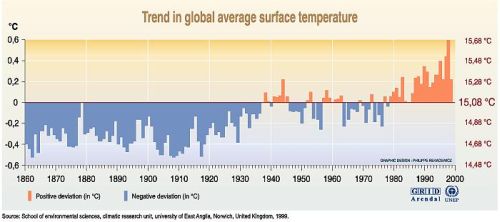
Land and Sea Surface Temperatures 1861-1998
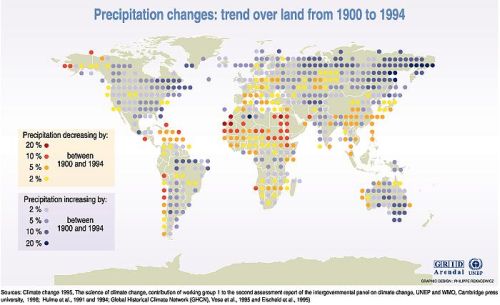
Land and Sea Surface Temperatures 1861-1998
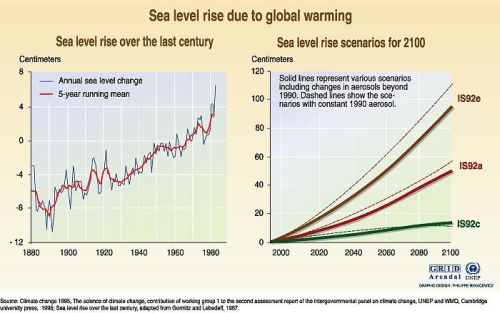
Land and Sea Surface Temperatures 1861-1998
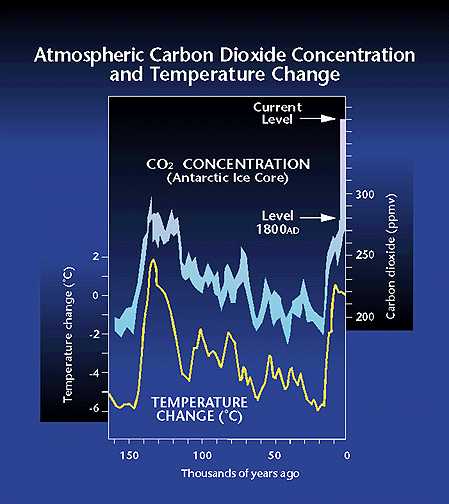
Historical Correlation Between CO2 Levels and Temperature Change
These four charts would seem to leave little doubt about the reality of profound climate changes over the past hundred years. Yet, at least in some quarters, as you well know, the interpretation or the use of such data is quite different from that of the vast majority of scientists. How can that be? Attempting to answer this question is a very revealing way to understand science and its relationship with society. In fact, the gist of this exercise can be applied to many other 'controversies' concerning science (e.g., Darwinian evolution and natural selection). Here are a few examples of the different 'spin' these data have been subjected to:- the methods used to collect the data are not reliable
- the data is inconclusive
- we shouldn't worry, or it's not our fault: the earth climate undergoes periodic fluctuations naturally
- to correct these trends would bankrupt the economy
- these trends are good for forest growth
- etc.
 What the Skeptics Don't Tell You.
Here I will simply sketch some responses to these objections in the order they are listed above:
What the Skeptics Don't Tell You.
Here I will simply sketch some responses to these objections in the order they are listed above:
- the methods used to collect the data have been critiqued and refined over the years, and the results
of many different methods appear to be converging towards a pretty solid unanimity among scientists. For
example, John Christy, at University of Alabama, "examined the accuracy of methods used to determine
air and water temperatures over the Earth's oceans. Traditionally, this has included ships' crews measuring
temperatures in the water hauled on to deck in insulated buckets or passing through engine intakes [ … ]
The study is likely to improve the scientific community's confidence in the satellite data, which cover more
than 95% of the globe, including remote ocean, desert and wilderness regions for which traditional climate
data are either scarce or not available at all."
[ from Seawater 'Overstates' Climate Warming ] - in science no data is ever completely conclusive, especially in the study of very complex systems. However, in this case the number and quality of independent studies, methods, and instruments is so large, that it is very difficult to dispute the data
- it is indeed difficult to exclude that natural cycles may be, at least in part, responsible for the signs of global warming we observe; at the same time, there is no question about the huge, and still increasing amounts of greenhouse gases we have been injecting in the atmosphere since the beginning of the industrial revolution, nor about the fact that such gases do contribute to global warming. In addition, the risks involved in blaming nature and not ourselves (and thus assuming a passive posture) are too serious for us to play Russian roulette
- the argument that any substantial action aimed at reversing our polluting habits would be disastrous for the economy is deeply disingenuous. The consequences of global warming will be such as to destroy, not simply harm the world's economy. We must be responsible for the state in which we will leave the Earth for our children, and their children, and so on. Failure to do so is grossly irresponsible, and incredibly myopic
- the claim that global warming would benefit plant growth is true only in the sense that certain species will indeed benefit from it, while many more—including some of the most common and essential crops—will probably disappear. Once again it is essential to look at the global picture, not at conveniently selected details. See, for example, Climate Change and the Northern Forests.
-
What is global warming? Here is
 Wikipedia's definition
(on this page you will find much more than a definition):
Wikipedia's definition
(on this page you will find much more than a definition):
"Global warming is an increase over time of the average temperature of Earth's atmosphere and oceans. It is generally used to describe the temperature rise over the past century or so, and the effects of humans on the temperature. The more neutral term climate change is usually used to describe previous natural variations. The term may be used to describe theories explaining such an increase or the crisis that many advocates say will arise if no one does anything to prevent such an increase from occurring."
When we release carbon dioxide (CO2), methane (CH4) and certain other gases into the atmosphere, we create conditions that increase the heat trapped into the atmosphere. The mechanism works as follows: incoming solar radiation warms the Earth's surface; some of it is re-radiated back into space as infrared light (if this didn't happen, the temperature of the Earth's surface would keep rising!); these gases render the atmosphere less transparent to infrared light, and thus increase its (and the Earth's surface) temperature. This is the so-called 'greenhouse effect.' The amount of anthropogeneic CO2 has increased by about 30% since the beginning of the industrial revolution.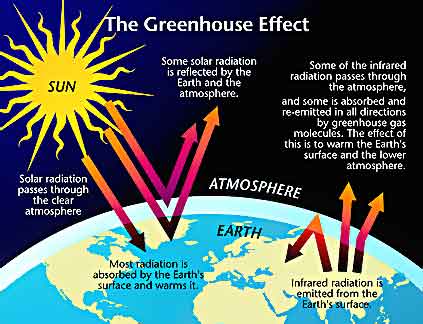
The Greenhouse Effect and Global Warming
Atmospheric circulation ensures that this effect is global, even if the sources of the gases are not. This is 'global warming.' It is of course important to know where the major sources of greenhouse gases are, because that's where action is most urgently needed. Here is a map that shows the relative contributions of various countries and regions (which have been resized to indicate their respective shares).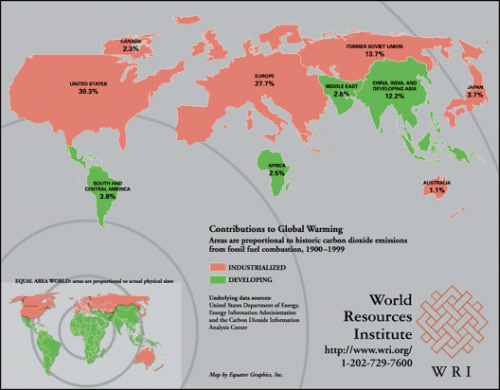
CO2 Contributions to Global Warming 1900-1999
-
In summary, here are the main data supporting the hypothesis that global warming may be already
happening [from Global Warming ]:
- "Since the beginning of the 20th century, the mean surface temperature of the earth has increased by about 1.1°F (0.6°C)
- Over the last 40 years, which is the period with most reliable data, the temperature increased by about 0.5°F (0.2-0.3°C)
- Warming in the 20th century is greater than at any time during the past 400-600 years
- Seven of the ten warmest years in the 20th century occurred in the 1990s. 1998, with global temperatures spiking due to one of the strongest El Niños on record, was the hottest year since reliable instrumental temperature measurements began
- mountain glaciers the world over are receding
- the Arctic ice pack has lost about 40% of its thickness over the past four decades
- the global sea level is rising about three times faster over the past 100 years compared to the previous 3,000 years
- there are a growing number of studies that show plants and animals changing their range and behavior in response to shifts in climate"
 Potential Outcome,
where you will find brief descriptions of the changes we are to expect, if we don't succeed in reversing
the current trends. In this respect, it is important to keep in mind that the processes associated with
global warming may be of the runaway kind: they may continue to accelerate, and we may not
be able to stop them, even if we ceased dumping greenhouse gases into the atmosphere now.
With regard to item 8. above, read Paul Epstein's Is Global Warming Harmful to Health?
which appeared in Scientific American August 2000 issue. Here is the subtitle:
"Computer models indicate that many diseases will surge as the earth's atmosphere heats up. Signs
of the predicted troubles have begun to appear."
Potential Outcome,
where you will find brief descriptions of the changes we are to expect, if we don't succeed in reversing
the current trends. In this respect, it is important to keep in mind that the processes associated with
global warming may be of the runaway kind: they may continue to accelerate, and we may not
be able to stop them, even if we ceased dumping greenhouse gases into the atmosphere now.
With regard to item 8. above, read Paul Epstein's Is Global Warming Harmful to Health?
which appeared in Scientific American August 2000 issue. Here is the subtitle:
"Computer models indicate that many diseases will surge as the earth's atmosphere heats up. Signs
of the predicted troubles have begun to appear."
-
Here is a very interesting and disturbing twist: "'Climate change' is popularly understood to mean
greenhouse warming, which, it is predicted, will cause flooding, severe windstorms, and killer heat waves.
But warming could lead, paradoxically, to drastic cooling—a catastrophe that could threaten the survival
of civilization." These words are by William H Calvin, and his argument is persuasively presented in a
famous article that appeared in the January 1998 issue of Atlantic Monthly,
The Great Climate Flip-Flop. This article is available in the Library. Read also
The Atlantic Heat Conveyor,
which explains the role of ocean currents in maintaining global climate. Recent evidence obtained by the
RAPID Program suggests that the
oceanic currents connected with the Gulf Stream are becoming weaker, diminishing the heat they supply to
North Atlantic regions.
The possibility of a global cooling is made more concrete by recent studies which suggest that
in the last few decades the earth has undergone a sort of global dimming.
You can read an article that appeared in the New York Times (May 13, 2004), Globe Grows Darker as Sunshine Diminishes 10% to 37%,
or a couple of editorials in CO2 Research Magazine: Solar Climatic Effects (Recent Influence)
and Diffuse Light: A Powerful Promoter of Photosynthesis.
The latter is "a review of the evidence for a widespread and significant reduction in global radiation with discussion of its
probable causes and possible agricultural consequences.." For a taste of how scientists discuss this issue, browse through
Beate G Liepert's paper Observed Reductions of Surface
Solar Radiation at Sites in the United States and Worldwide for 1961 - 1990.
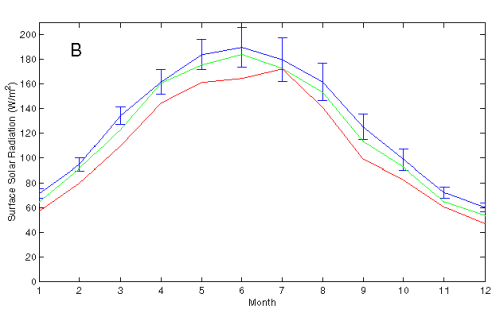
Blue: 1961 - 1970; Green: 1971 - 1980; Red: 1981 - 1990. Overcast Skies
Note that it is very questionable whether global dimming may offset global warming, and therefore it can not be used in support of arguments that the climate is not undergoing drastic changes. -
"The ozone issue and Greenhouse Warming are related yet distinct scientific issues.
In the lower atmosphere (called the troposphere), the ozone does act as a greenhouse gas,
trapping outgoing radiation that would otherwise escape into space. Compared to carbon
dioxide, ozone is a minor greenhouse gas. The significance of tropospheric ozone may be
increasing however, due to the burning of fossil fuel which generates ozone (commonly
recognized as a component of smog) into the lower atmosphere." [ from What is 'Global Warming'? ]
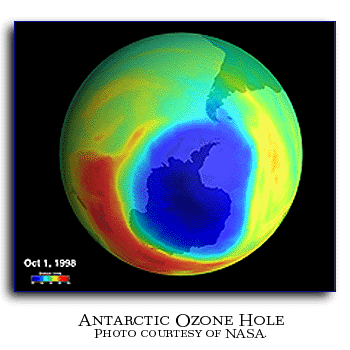
Note that the 'hole' shown above is no longer confined to Antarctica, but has appeared in various parts of the globe, including the Northern Hemisphere.
Readings, Resources and Questions
- The most recent information (30 January 2006) is contained in an official UK report which "builds on findings from the Avoiding Dangerous Climate Change conference, held at the Met Office last February".
-
Read also
 Global Temperature Trends: 2005 Summation,
Global Temperature Trends: 2005 Summation,
"The highest global surface temperature in more than a century of instrumental data was recorded in the 2005 calendar year in the GISS annual analysis. However, the error bar on the data implies that 2005 is practically in a dead heat with 1998, the warmest previous year [ … ] Global warming is now 0.6°C in the past three decades and 0.8°C in the past century. It is no longer correct to say that "most global warming occurred before 1940". More specifically, there was slow global warming, with large fluctuations, over the century up to 1975 and subsequent rapid warming of almost 0.2°C per decade."
-
Other dramatic evidence of global warming (and its relationship with ice ages) is available in a series
of articles published in the June 10 of Nature. In particular, you may read "Palaeoclimate: Frozen Time"
(Nature 429, 596 - 597 (10 June 2004): "Researchers have pulled the oldest-yet core of ice from the Antarctic,
giving us a 740,000-year record of the planet's climate. Gabrielle Walker braves the cold to find out how they did it, and what they
hope to learn." Go to the Library to read the article.
Another recent result:
"The oceans have soaked up nearly half of the carbon dioxide released by industrial activity during the past two centuries, researchers say, and changes in ocean chemistry could pose a long-term risk to corals and shell-forming marine life.
See also (November 2004): Observed Impacts of Global Climate Change in the US, a report prepared for the Pew Center on Global Climate Change by C Parmesan and H Gilbraith.
The findings suggest that burning fossil fuels such as coal and oil could have ecological consequences by the end of the century that go beyond current concerns about global warming." [ from Bad Air Hurts Sea Life ] -
For a taste of the agricultural effects of global warming, read Global Warming. Impacts: Agriculture, or
 Rice Yields Dip as Planet Warms.
Rice Yields Dip as Planet Warms.
"The researchers studied 12 years of rice yields and 25 years of temperature data, to work out how they are linked. Yields dropped by 10% for each degree of warming, an alarming trend since rice is the staple diet for most of the world's expanding population, they say. The study, by an international team, appears in the Proceedings of the National Academy of Sciences journal."
- Read The Kyoto Protocol, and visit some of the UN links included there.
-
Research the potential harmful effects that global warming would have on our health. Here
are some starting points:
"A warming earth will most likely have a spectrum of largely negative impacts on human health. The predicted decrease in the difference between day and night temperatures will result in more thermal extremes. Therefore, an increase in mortality from heat stress is likely (e.g. 465 deaths in Chicago during the summer of 1995). As a result of warming, the area of the earth's surface experiencing 'killing' frosts will probably decline. As a result, there will likely be an increase in the geographical range of vector-borne (e.g. mosquito carried) diseases such as malaria, dengue, yellow fever, and encephalitis. Currently, 45% of the world's population is within the zone of potential malaria transmission. With predicted temperature increases, there will likely be an additional 50 to 80 million cases of malaria worldwide, bringing the percentage of the world's people within the susceptible zone to 60%. It is also likely that increasing temperatures will result in a decline in air quality due to increases in the abundance of air pollutants, pollen, and mold spores. An increase in the number of cases of respiratory disease, asthma, and allergies is likely to follow. The change in the frequency and intensity of extreme weather events (e.g. floods and droughts) combined with warmer atmospheric temperatures, will probably result in a host of adverse health effects, among them, exposure to contaminated water supplies and death from diseases." [ from Potential Outcome ]
-
Read
 Earth's Cloud Forests Threatened.
"Pressures are mounting on one of the Earth's rarest and most distinctive types of forest, scientists have found.
The alert comes from the UK-based World Conservation Monitoring Centre, now a part of the UN Environment Programme.
It says the threats to the world's cloud forests, which shelter thousands of rare species and provide water for
millions of people, are increasing [ … ] Threats include farming, poaching, fires, logging, road-building
and the introduction of alien species. But the authors think climate change could be the biggest danger."
Earth's Cloud Forests Threatened.
"Pressures are mounting on one of the Earth's rarest and most distinctive types of forest, scientists have found.
The alert comes from the UK-based World Conservation Monitoring Centre, now a part of the UN Environment Programme.
It says the threats to the world's cloud forests, which shelter thousands of rare species and provide water for
millions of people, are increasing [ … ] Threats include farming, poaching, fires, logging, road-building
and the introduction of alien species. But the authors think climate change could be the biggest danger."

In the Mexican Mist (Image: Philip Bubb)
You may also want to look at a similar article on SciDev.net, Destruction of Cloud Forests Threatens Water Supply, which includes a link to the full UNEP report.
Picture Credits: UNEP/GRID-Arendal · WHRC · NACC/USGCP · WRI · NOAA · BBC
Last Modification Date: 30 December 2006